I wanted to do something special in the way of commemorating the efforts of these individuals, and so I set out to interview a number of them as the year drew to a close. Sadly, I was never able to piece those interviews together in a proper story like I would have wanted, but in recent weeks it has occurred to me that it may be just as beneficial to offer up something you don't regularly see: a personal compilation of the greatest single images from the cinematic year.
And so it goes that I offer the Top 10 Shots of 2007, a two part piece that will run down what I felt were the best of the best in a year full of exceptional cinematographic work. Today, I'm running down shots 10 through 6, and tomorrow, we'll wrap it up with the top 5. Mixed in you'll find sporadic comments from the lensers in question, as I feel it only appropriate that I give that small gateway into their process for readers and viewers alike.
I hope you enjoy reading this as much as I did compiling it.
#10
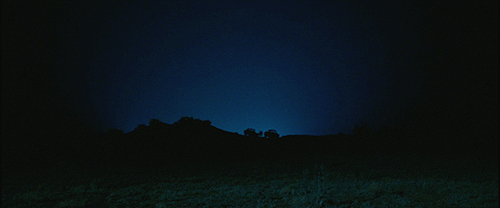
"NO COUNTRY FOR OLD MEN"
Director of Photography: Roger Deakins
I suppose in a way it was business as usual, but business is never usual with [the Coens], because every film they've done is so different. And I think we felt quite a responsibility to the novel. Visually, graphically, it was a very different look than what we'd been doing together up until then. It was like a Peckinpah western, the old sheriff standing in the way of the way the world was going.
–Roger Deakins
There is an embarrassment of iconic images peppered into Roger Deakins' greatest creative collaboration with the Coen brothers to date. Any one of them could be spotlighted as indicative of theme or substance, tone or atmosphere throughout.
There is, of course, the instantly classic shot of Lewellyn Moss sprinting through the open country in the dead of night, the headlights of a pickup in hot pursuit, silhouetting his figure against a pitch black night (used frequently in the film's PR). And who could forget any number of frames from Moss and Chigurgh's hotel confrontation, the darkening of a hallway light bulb, the jaundiced yellow swaths of street lamp bathing the interior of the room, Moss lying in wait, shotgun in hand?
For me, the image that always stood out is the one that gave me the most discernible start. As much attribution may be given to the editing of the sequence, but there is Moss, waltzing back into the lion's den of a drug deal ambush and discovering he might not be alone. He turns back to the ridge and there is his truck, suddenly accompanied by another and visually framed at such a distance as to play a trick on the viewer. "Wait, is that…? Fuck!" It isn't the prettiest frame of the film, but it is the one that sticks with me, the one that, more than any other, captures the sheer anxiety of the endeavor.
#9
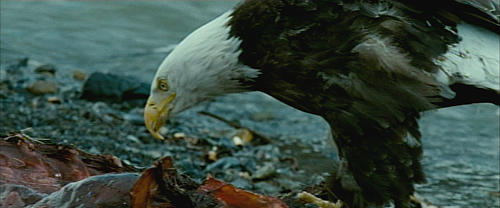
"INTO THE WILD"
Director of Photography: Eric Gautier
One of the unsung heroes of the season this year had to be lenser Eric Gautier, who captured Sean Penn's "Into the Wild" on film in such a way as to both electrify and provide a basis for deep consideration of theme and character. Gautier was tasked with depicting the American frontier through the eyes of disenchanted youth, and in so doing he managed to plumb considerable depths with his imagery.
Take this shot of a bald eagle tearing away at the rotting flesh of a sacrificed moose. Chris McCandless, so desperate to prove to himself and to, in some small way, humanity, that he could live off the land in Alaska, he hunted and killed the animal, attempted to smoke the meat but found the process too much to complete, too beyond him to handle. There are cutting themes in this flawed film about the country weighing on a person's psyche, about the desire to leave it all behind and escape the small tragedies of everyday life. The American way is there, though ever elusive, picking away at the flesh of scattered dreams.
It's a subtle image, on screen for maybe five seconds, and likely dominated by the pack of wolves partaking in the feast. But it resonated with me. It struck a chord that made me all the more proud of Sean Penn for the dedication he put into this effort, no matter my opinion of the final result. And Gautier is at the forefront of that vision, a brilliant visual guide through the wild of America's wounded heart and bitter soul.
#8
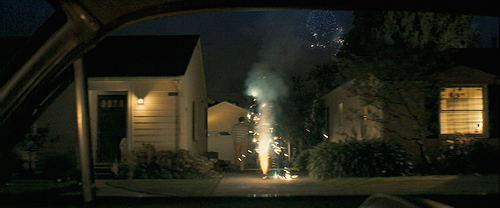
"ZODIAC"
Director of Photography: Harris Savides
Steven Shore had these banal kind of images of America in the 70s, which were a great reference for colors and for props, and for the world that we were to inhabit and make the audience feel they were watching. Something that did concern me, however, was that it was very dialogue-driven, and I wanted to do things that were more cinematic. But all of David's references were these wonderful movies that had this structure that I became interested in. The approach that he wanted to take was exciting for me.
–Harris Savides
Harris Savides sat behind the camera of three solid visual achievements in 2007: Ridley Scott's "American Gangster," Noah Baumbach's "Margot at the Wedding" and David Fincher's "Zodiac." His versatility can be felt throughout his work on these vastly different projects, but it was on the latter that he proved a certain capacity for mainstream artistry as of yet untapped.
Much of Savides' work in the film was buttressed by visual effects. In many cases, the seams are so transparent as to become a mere afterthought, but one shot, simply accentuated by CGI in the background, really spoke up on the film's upcoming presence and period immersion. Not quite the opening image (the second, actually, following a CGI establishing shot of the Bay Area during the 4th of July), the shot is a trek through a celebratory neighborhood as Three Dog Night's "Easy to Be Hard" settles into the bones.
The tone Savides sets with his framing and lighting is one of instant foreboding, an almost sickening sense of impending doom. When I think of "Zodiac," I immediately think of this image and something cold sits in my stomach. It gets me every time.
#7
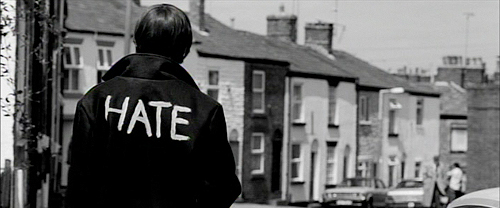
"CONTROL"
Director of Photography: Martin Ruhe
Black and white always has the danger of being too stylized, but Anton is great at being efficient and taking risks and not questioning too much. That gave us confidence to go ahead with things. We wanted to make the film really personal and daring in a lot of ways.
–Martin Ruhe
Cinematographer Martin Ruhe had been a frequent collaborator of director and photographer Anton Corbijn in the music video world, where Corbijn had cranked out more than a few shining examples of visual acuity (Nirvana's "Heart-Shaped Box," Rollins Band's "Liar"). When the time came for Corbijn to make the leap to feature films, it was only fitting that he bring Ruhe along to attack the photography of the endeavor. Indeed, the lenser and filmmaker managed to capture their fair share of iconic imagery on the way to cinematically immortalizing Joy Division front man Ian Curtis.
The shot that springs to my mind is one that not only assures the viewer of Ruhe's skillful hand behind the camera, but one that announces Corbijn as a visually dynamic filmmaker who promises to be an exciting talent to watch in this new phase of his career. Curtis walks down the street having donned his infamous "HATE" jacket on the way to the local employment offices as Joy Division's "No Love Lost" attacks the cerebellum. It's the perfect transition into the second act of the film and really sucks the viewer in.
There are, of course, numerous other images of note in "Control." The final shot of smoke rising in the extreme bottom of the frame following the heart-wrenching denouement might come to most minds. But whatever your favorite shot, it is refreshing to see a first time director so comfortable with the narrative medium and so capable of conveying visual meaning, thanks in no small part to the work of Ruhe, a solid fit for Corbijn's expressionist tendencies.
#6
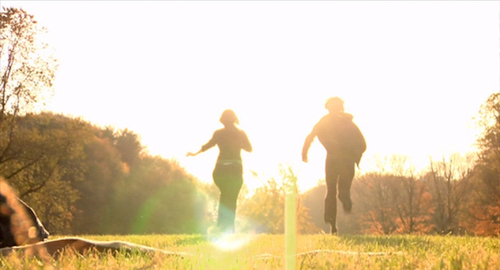
"QUIET CITY"
Director of Photography: Andrew Reed
The Prospect Park scene was the best example of a happy accident. It was not something that Aaron and I talked about a great deal. Though there were some basic ground rules. Obviously the movie is 80-90 percent handheld, and that was a conscious choice. We also made the decision that all of the cityscape shots were going to be completely static and separate from those other shots. We didn't want there to be any additional presence other than the city.
–Andrew Reed
It's no secret that I fell in love with the warmth and realism of Aaron Katz's "Quiet City," but something that always resonated with me was the subtle and yet purposeful work from lenser Andrew Reed. In a movement consistently spotlighted for its minimalism ("mumblecore," the kids are calling it), I find myself arguing for "Quiet City" as an entity unto itself. Much of my reasoning has to do with Reed's efforts in setting the film apart visually, while at the same time clearly working with the influence of his idols in the field.
The shot that became the film's calling card has, in effect, become the film's cliche. But cliches aren't always a whitewashing of reality, and this image has the goods and captures the heart of Katz's film in one fell swoop. The central duo, Jamie and Charlie, decide upon a spontaneous race in the middle of a sun-washed
park. Noticing the descending sun and the opportunity to capture something special, Reed set the camera on the ground and aimed into the light, capturing the characters in a long take as they run away from and then back toward the frame. It sounds trite but it is, in fact, beautiful.
I really hope Reed and Katz continue to collaborate on future efforts, because they seem to have a chemistry that unfolds on the screen in very special ways. Sometimes shots are a stretch or otherwise self-aware, sometimes the opportunity to break out of a visual shell is lost, but more often than not, they settle into a splendid groove and will surely continue to solidify their visual voices.
#5
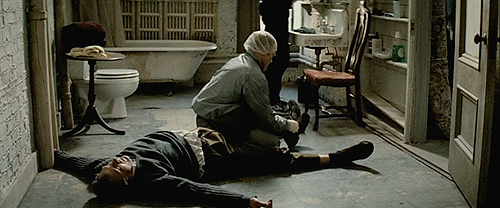
"MICHAEL CLAYTON"
Director of Photography: Robert Elswit
We were completely ripping off New York filmmaking from the 1970s, things like "Klute" and pretty much everything Owen Roizman has ever shot. But Tony's sense of these things was not lots of little pieces; he loves making kind of graphic frames that play as long as possible.
–Robert Elswit
Robert Elswit had a hell of a year in 2007, finally getting his due from the American Society of Cinematographers who awarded his work in Paul Thomas Anderson's "There Will Be Blood." There was another film featuring Elswit's unique signature, however, that flew under the radar for its considerable attention to composition and camera movement: Tony Gilroy's "Michael Clayton."
Much is made of the film's final sequence, a long shot focused on Clayton as he rides away from the hysteria in his life, desperate for his cab driver to "just drive." But a companion shot from earlier in the film was just as arresting, if not more so, as a purposeful point of transition to the second half of the endeavor. A long tracking shot that never misses a beat, both behind and in front of the camera, the scene detailed is the expert, painfully clinical execution of Arthur Edens, played to an award-worthy T by Oscar nominee Tom Wilkinson.
The final image is steeped in theme, and an initial tracking sequence under Edens' opening monologue pulls the viewer into the film's interior world, but this particular shot is so cold as to be frozen in its depiction of something at once gruesome and strangely beautiful, fluid. I'm not privy to whether it may have been a directorial decision, though I suspect it may have been, but it is the crown jewel in a film packed with precision from Elswit.
#4
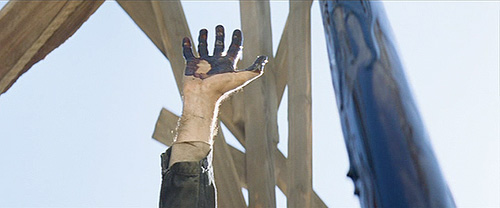
"THERE WILL BE BLOOD"
Director of Photography: Robert Elswit
If we were stealing from anybody, it was a little bit of Kubrick. But that tends to be kind of Paul's taste anyway. But in terms of temperature — and we've said this a million times — it was 'Treasure of the Sierra Madre.' We really wanted a sense of that. Oil drilling was a really hard life, and I think Paul was absolutely obsessed with capturing that.
–Robert Elswit
Elswit bumps up against himself here, one of the countdown's two individuals with dual representations. The imagery throughout "There Will Be Blood" is instantly classic, much like it's sister film, "No Country for Old Men." The ASC has seen fit to reward Elswit for his work on the picture, and with due cause. The result of "Blood" is a testament to the artistic splendor of the lenser's 5-film collaboration with director Paul Thomas Anderson.
The shot that stuck out in my head the very first time I saw the film spoke to me so deeply that I referenced it in my initial review: "A few years trickle by as Plainview adds onto his enterprise until finally, oil. A black-tarred hand reaches to the sky and suddenly you sense the influence of Stanley Kubrick on the film. Like the apes who discovered weaponry in "2001: A Space Odyssey," Plainview has come upon the object that will dictate America's destiny for the next century and more." I don't thiink I could say it any better now.
Indeed, the Stanley Kubrick reference is palpable, and obviously, Elswit is on the record as saying the work of the highly visual director was referenced on the film. It is perhaps the most Kubrickian image of the year, which is saying something, given the number of times the filmmaker's name has been evoked in critical discussion of the year's cinema.
#3
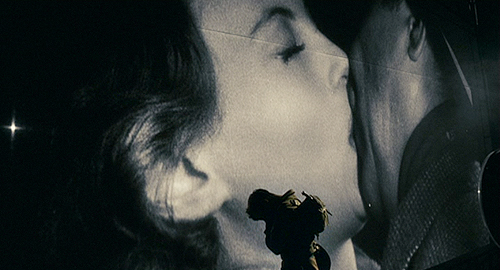
"ATONEMENT"
Director of Photography: Seamus McGarvey
Joe and I are very clear that cinematography must be in service of the story. With the unfettered imagination, meaning can just explode and proliferate. So we wanted to keep in line with the script's insistence on no adjectives, keep things clean as a whistle, very clear and with unfiltered light.
–Seamus McGarvey
Perhaps the most talked about shot of the year is the 5 minute-plus tracking scene of Dunkirk in Joe Wright's "Atonement." Seamus McGarvey served lensing duties on the pic, but camera operator Peter Robinson perhaps deserves most of the credit for that shot. However, it is an image just moments later that was most striking to me and, indeed, more thematically relevant.
Robbie Turner, robbed of four years of his life due to false charges, painfully in love with Cecilia Tallis, desperate to return to her arms, is injured, his life draining away, his exhaustion taking its considerable toll. In front of a theater screen, his anguish plays out expressionistically behind him as a black-and-white romance shines bright on the screen, two lovers locked in a kiss. Robbie holds his head in his hands, everything…slipping away.
This shot means so much more than any other image in the film. And while McGarvey and Wright's (and Robertson's) Dunkirk odyssey has been unfairly maligned as it is, I have to say, not enough attention has been paid to the visual splendor found elsewhere. And I still contend this might be a dark horse in the cinematography category at this weekend's Oscar ceremony.
#2
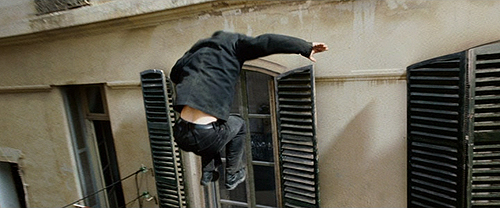
"THE BOURNE ULTIMATUM"
Director of Photography: Oliver Wood
Thankfully, Universal's "Bourne" franchise finally received its fair share of film awards acknowledgment this year as the best film in the series received three Oscar nominations. Sadly, a tip of the hat to lenser Oliver Wood wasn't in the cards, but that's okay. He and his crew were responsible for one of the most jump-out-of-your-seat images of the entire year — perhaps the entire decade — in Paul Greengrass' "The Bourne Ultimatum."
At the end of an involved and lengthy (some would say too much so) action set piece that dazzles the viewer with both visual skill and editorial expertise (thank you Christopher Rouse), Jason Bourne fixes in on his target, the elusive "asset," a building away, closing in on the unsuspecting Nicky Parsons. A split second decision from the robot-like former government operative and Bourne sprints toward a window, out onto a ledge and leaps headlong into the air. Typicality would suggest a simple profile view of Bourne crashing through the oncoming window, but no. Wood and company followed the character through the air, hell, through the WINDOW, on the way to eliciting gasps and perhaps cheers from spellbound audiences.
Dazzling. Simply dazzling. And the only drawback is that the sequence was spoiled in PR and trailer promotions for the film, but no matter. If half the industry's cinematographers were willing to be this brazen and think this far outside the box (and really, the concept doesn't seem that far-fetched in a close analysis), we'd be in for treat after visual treat.
#1
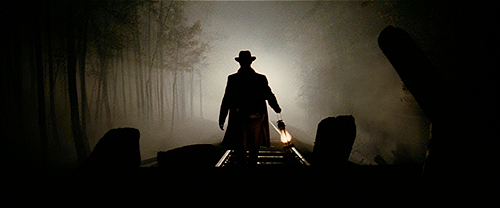
"THE ASSASSINATION OF JESSE JAMES BY THE COWARD ROBERT FORD"
Director of Photography: Roger Deakins
Andrew said he wanted to create a Victorian Western, and he had a lot of visual references, from photographs to paintings and stills from other movies. But this was the 1870s, kind of late for a western. Jesse James was around at a time when the west was really changing; he lived in an area that was bustling. And Andrew wanted to get across that notion of change.
–Roger Deakins
It may seem almost cliche to select an image from Andrew Dominik's "The Assassination of Jesse James by the Coward Robert Ford" as the single greatest shot of the year, but let's face it — it's true. Any number of images from this film would blow the competition out of the water, and indeed, it was a fool's errand to select just one. Jesse James obscured by tall wheat; his iconic image approaching a stopped locomotive, doused in smoke and steam; snow-streaked scenes washed out in stark beauty; his dead, displayed body reflected in the lens of a camera — you name it.
What I settled on was the image directly following a moment that hinted to us that this may be Deakins' greatest work to date (that being a somewhat experimental shot of a locomotive approaching the camera and taking us on a ride). The image in question lifted my heart to take it in: Jesse James, the outlaw, approaching a rise of wooden debris, awaiting an oncoming train as the engine light casts his shadow in the center of the frame. It's simply gorgeous, a testament to the possibilities of iconic imagery within the genre (possibilities strangely untapped throughout the years, for the most part).
But truthfully, I could post image after image after image from this exceptional piece of work and easily fill a list of ten. This one was monumental, though — demonstrative of a career pinnacle for the lenser, a singular vision of an American art form from the mind of an Aussie and the eye of a Brit. I can't tell you how in love I am with the imagery of "Jesse James," except to say how undeniably deserving Deakins is of an award for what he accomplished. Here's hoping…right?
Well, that wraps up my personal compilation of the year's greatest images. Astounding work from so many, and indeed, so many left off the list:
Janusz Kaminski vibrantly depicted "The Diving Bell and the Butterfly" in ways almost aggressive in their creativity. Phedon Papamichel re-invented the western genre as a modern actioner in "3:10 to Yuma." Rodrigo Prieto filled his frames with aching thematic resilience in "Lust, Caution." And Ed Lachman brought Todd Haynes's twisted, surreal and avant garde vision of Bob Dylan to life in exciting ways in "I'm Not There." But 10 is 10.
The top 10 shots of 2007
No comments:
Post a Comment